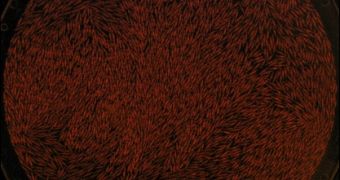Generally, the action of swarming applies to the animal kingdom, for instance to schools of fish, groups of insects and birds. This aggregation of similar elements that help animals find mates and survive predator attacks has now been successfully achieved in artificial systems made of copper rods.
Vijay Narayan of the Indian Institute of Science in Bangalore and colleagues in the US have produced the first swarm of tiny copper rods that fluctuate largely from one place to another. The density fluctuation of these rods mimics that of fish rapidly changing directions and could help scientists understand the mechanisms that spawn this phenomenon.
In an experiment, they took thousands of short copper rods, each one less than a millimeter thick and made them vibrate between two horizontal plates. All the rods are symmetrical and should, in theory, vibrate exactly the same.
Measuring the density fluctuations for various bathes of rods vibrating between the plates, the scientists discovered that the more rods were concentrated in one area, the larger were the fluctuations, which led to a more visible swarming behavior.
To confirm that this was not just a fluke, they took snapshots of various parts of the system at a 15 second interval, for a period of 40 minutes and the results were the same. What's also interesting is the fact that the tiny rods did not swarm until they were etched at either end, which made them take on the shape of a rolling pin.
So far, they did not discover why this modification was necessary, but Narayan thinks that it was similar the movement of nematic liquid crystals, which are known only to comprise molecules with a rigid inner section and bendable extremities.
It seems that shape really matters in the formation of swarms, at least on the nanoscale, commented Martin van Hecke, a condensed-matter physicist from Leiden University in the Netherlands.
Narayan concluded that this new experiment proves that swarming, similar to what is seen in the animal kingdom, does not require communication as an absolute condition, but can occur with simple particle-particle interactions.
"It should provide encouragement to others to carry out quantitive tests of 'flocking' models by measurements of bird flocks, fish schools or giant herds of migratory beasts," he added.

 14 DAY TRIAL //
14 DAY TRIAL //